March 9 - 15, 2014: Issue 153
The Australian Florin – Worth More than 20 Cents to Collectors
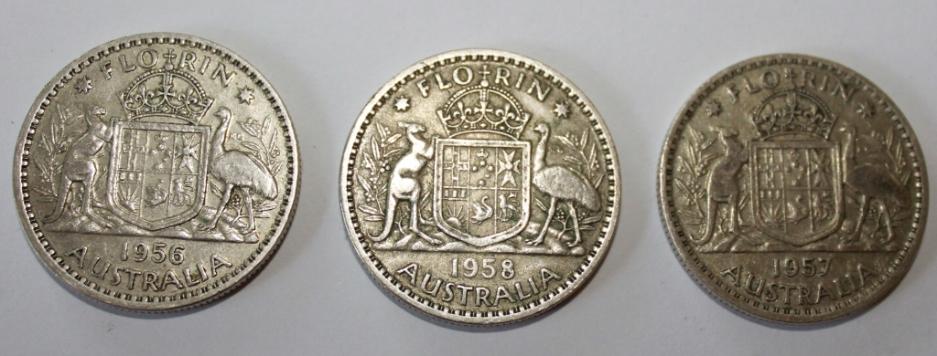
The Australian Florin – Worth
More then 20 Cents to Collectors
The Australian
florin was a coin used in the Commonwealth of Australia before decimalisation.
The florin was first minted in 1910, to the same size and weight as the United
Kingdom florin. Florins minted from 1910 to 1945 were produced with a .925
sterling silver content, weighing 11.31 g (0.3364 troy ounces) with an actual
silver weight (ASW) of 10.46 grams (0.3363 ozt). Florins minted between 1946 and
1963 were produced with a .500 silver content, weighing 11.31 g with an ASW of
5.65 g (0.1818 ozt). The florin was worth 24 pence, two shillings or a tenth of
a pound. The coin was minted until 1963, with some years of omission. When
Australia decimalised on 14 February 1966 the florin was equal to
20¢.
During World War II, between 1942-1944, florin production was supplemented by coinage produced at the San Francisco branch of the United States Mint. These coins bear a small "S" mint mark below the Australian coat of arms.
The image on the reverse of the coin was the Coat of Arms of Australia (except for commemorative coins). This comes in two forms, all with the kangaroo, emu and the shield containing the coat of arms. Those issued between 1910 and 1936 have a star above the Coat of Arms, and the Southern Cross within the shield. Those issued between 1938 and 1963 have the royal crown above, the six states represented in the shield and wattle plant as a background.
The word ‘florin’ comes from the name of a gold coin first
issued at Florence, Italy, in 1252. It is also noted as: A guilder. A British
coin worth two shillings. Any of several gold coins similar to the Florentine
florin, formerly used in Europe. The word is from Middle English, from Old
French, from Old Italian fiorino, from fiore, flower (from the
lily on the coins), from Latin flōs, flōr-, flower.
With the high
percentage of silver in these coins you may think it worth selling them by
weight but with silver around $21 per troy ounce, whereas gold is around $1300
per troy ounce, you would do better with the original gold florins. (One troy
ounce has a little more than 31 grams in it.)
It is still the coin itself
that will produce the most if reselling or keeping for investment. For example,
a 1928 Florin, if in mint condition, will sell for around $1350.00 Australian
dollars, or if it has been used and shows signs of wear, will sell from between
$8.00 to $300.00.
A 1940 Florin could fetch up to $165.00 if in mint
condition. The amount of coins distributed (8.41 million were minted for 1940
version) and the rarity are what drive prices higher. Earlier versions, like the
1913 Florin of which only 1.2million were minted, may costs up to $12 600.00 for
one in mint condition, and for one in a less then ‘mint’ condition, prices range
from $35.00 up to $2000.00.
Even the 1954 version will fetch $32.00 – a
lot more than it’s ‘20 cents’ face value!
A few insights on florins from
the pages of the past shows the florin was used as a special commemorative coin
for events, just as our coins are nowadays, that social events as ‘florin
Afternoons and Evenings’ were popular fundraisers while critiques of the florin,
and its modifications, were subjects for discussion:
NEW BRITISH FLORIN COIN REGARDED WITH
SUSPICION. LESS SILVER USED
Melbourne. Friday.
Trades people have regarded
with suspicion a new type of florin which has lately appeared in Australia. It
is slightly discolored and lacks the ring of the Australian coin. This is one of
the new coins issued by the British Treasury on a remodelled basis and contains
much less silver than the old British coin or the present Australian coin. The
florin, however, is legal tender and worth its full face value. The silver
contents of the new coin are only one-half, whereas the silver in the Australian
florin represents 37-40ths of the metal.
Steps are being taken, with the
consent of the Imperial Government, to reinstate, the system of gradual
withdrawals without reissues. By this means Australian coinage will gradually
again assume the monopoly of the Commonwealth circulation. NEW BRITISH
FLORIN CON REGARDED WITH SUSPICION. (1921, December 30). Barrier Miner
(Broken Hill, NSW : 1888 - 1954), p. 1. Retrieved from http://nla.gov.au/nla.news-article45572020Right:
Reverse of the 1927 Australian florin commemorating the opening of the original
Parliament House.Designed by George Kruger Gray.
THE CANBERRA FLORIN. The new florin being coined by Royal Mint
in commemoration of the opening of Parliament. The head side , bears the King’s
profile, and the- tail side an engraving of Canberra Parliament House. The
design was kept secret for months. ~About 2,000,000 will be released
simultaneously by banks on May 9. THE CANBERRA FLORIN. (1927, April
5). The Register(Adelaide, SA : 1901 - 1929), p. 10. Retrieved from http://nla.gov.au/nla.news-article54099890
CENTENARY FLORIN. Commemoration Coins Face Value of
£7,500
CANBERRA, October 8.
Authority has been given by the Federal
Government for the minting of a florin to commemorate the Victorian Centenary.
The minting of the Centenary florin will be begun at the Royal Mint in Melbourne
on Wednesday, and the Governor of Victoria (Lord Huntingfield)will strike the
first of the new coins.
The issue of the Centenary florin will be limited to
coins having a face value of £7,500.The florin will be the same size as the
ordinary Australian florin. On its obverse side it will bear a crowned effigy of
King George V., and on the reverse side will be a horseman carrying a flaming
torch. CENTENARY FLORIN. (1934, October 9). The Mercury
(Hobart, Tas. : 1860 - 1954), p. 7. Retrieved from http://nla.gov.au/nla.news-article29161945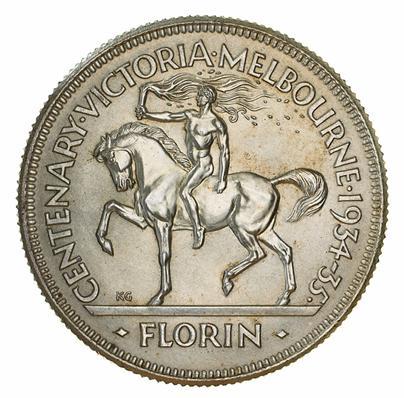 We went to find out
‘why a horseman with a flaming torch’ and found one in mint condition currently
for sale at AU $7,823.84 while even a version that has clearly been used will
command $449.00. According to most reports the official Centenary symbol was a
torchbearer mounted on a prancing horse.
We went to find out
‘why a horseman with a flaming torch’ and found one in mint condition currently
for sale at AU $7,823.84 while even a version that has clearly been used will
command $449.00. According to most reports the official Centenary symbol was a
torchbearer mounted on a prancing horse.
Museum Victoria tells us: “ the
alternative Name for this coin was Melbourne Centenary Florin. They were Issued
to commemorate the hundredth anniversary of Victoria (1834) and the foundation
of Melbourne (1935). The coins were sold at a premium of one shilling to help
finance the celebrations. 75,000 were struck, but at the end of the event 21,000
remained unsold and were melted. It features the centenary logo of an equestrian
figure, slightly modified to fit the circular format of a coin (the logo was set
in an oval)."
Some sources state Sales of the florins were so lack lustre that
as the time of the final events approached in June 1935, just 15,000 coins had
been sold. Mention was made in the Melbourne newspaper that “a local company has
an option on 30,000” coins. The department store of Foy & Gibson distributed
numerous Melbourne Centenary Florins in small paper pouches to their customers,
and so it is thought this was the company referred to. - See more at HERE
The Torchbearer motif was used on stamps as well:
Centenary Stamps
Mr. C. B. Nicholson, deputy organiser of the
Centenary celebrations, reminds citizens that Centenary stamps, which bear the
official emblem, an equestrian torch-bearer, are on sale at Id. each at all news
agents throughout the metropolitan area. They should be affixed to letters next
to the usual postage stamp. The cost is so 'small that everyone can help the
Centenary Council's appeal by small or large purchases of these stamps.
Centenary Sidelights. (1934, October 18). The
Argus(Melbourne, Vic. : 1848 - 1957), p. 15. Retrieved from http://nla.gov.au/nla.news-article10977893
Florin
Evenings and Afternoons examples throughout the 1920’s, 30’s and 40’s as a means
for raising funds for worthwhile causes:
FLORIN
AFTERNOON. A florin afternoon will be held tomorrow (Thursday), at three'
o'clock, in St. Peters’ Parish Hall, East. Maitland, In aid of the plain and
fancy stall of St.. Peters’ bazaar. FLORIN AFTERNOON. (1924, August
13). The Maitland Daily Mercury (NSW : 1894 - 1939), p. 4. Retrieved
from http://nla.gov.au/nla.news-article125804322
FLORIN AFTERNOON-A florin afternoon, will be held on September 11
at the Church of England Girls Hostel. See advt. FLORIN AFTERNOON.
(1943, July 16). The Charleville Times(Brisbane, Qld. : 1896 -
1954), p. 2. Retrieved from
http://nla.gov.au/nla.news-article79351271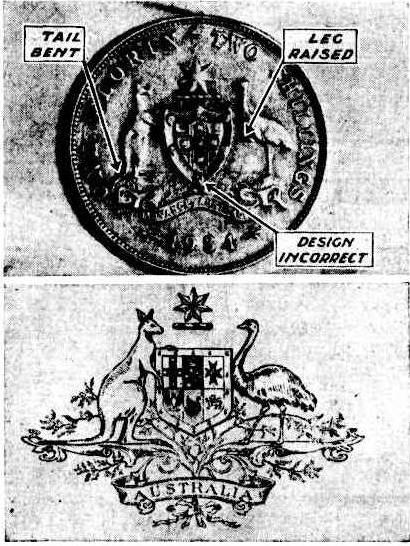 AUSTRALIAN
COINAGE DESIGN. INACCURACIES IN THE DESIGN of the Australian florin, which will
be corrected in the new issue, to bear the effigy of King Edward VIII., and a
reproduction of the Commonwealth coat of arms. The Federal Treasurer (Mr. Casey)
said the design of Australian coinage was not one of which Australians should
feel proud. Tentative designs had been prepared, but modifications were
necessary before adoption. AUSTRALIAN COINAGE DESIGN. (1936, October
19). The Mercury (Hobart, Tas. : 1860 - 1954), p. 2. Retrieved from
http://nla.gov.au/nla.news
article30117658
AUSTRALIAN
COINAGE DESIGN. INACCURACIES IN THE DESIGN of the Australian florin, which will
be corrected in the new issue, to bear the effigy of King Edward VIII., and a
reproduction of the Commonwealth coat of arms. The Federal Treasurer (Mr. Casey)
said the design of Australian coinage was not one of which Australians should
feel proud. Tentative designs had been prepared, but modifications were
necessary before adoption. AUSTRALIAN COINAGE DESIGN. (1936, October
19). The Mercury (Hobart, Tas. : 1860 - 1954), p. 2. Retrieved from
http://nla.gov.au/nla.news
article30117658
As you can see from our photo of the 1950’s range of
Florins we own, this design was not modified. A small item in 1937 states the
tail turning up was by design;
NEW FLORIN. The design
(top) for the new two - shilling piece. The reverse side will show the head of
the King without a crown. The proposed new coin is shown compared with the
present issue. It will be noticed that the tail of
the kangaroo on the new coin is turned up instead of down. NEW
FLORIN. (1937, December 24). The Argus (Melbourne, Vic. : 1848 -
1957), p. 1. Retrieved from http://nla.gov.au/nla.news-article11135296
FLORIN PRAISED
The new florin, showing the Australian coat of
arms.
"Handsome Coin"
"One of the most handsome coins I have ever seen,"
was the comment of the master of the Royal Mint(Mr. E. T. Clucas) last night on
the new Commonwealth florin.
The first of the new coins was struck yesterday
by Mrs. R. G. Casey, the wife of the Federal Treasurer (Mr. Casey). The reverse
side of the design shows the new coat of arms, representative of all the
States, supported by an emu and a kangaroo.
Mr. Clucas said that officers of
the Mint had been particularly pleased with the manner in which the design had
been shown in bold relief on the coin. A feature was the detail of the design.
It was a coin of which Australia would be proud. The obverse side of the coin
bears the head of King George VI. FLORIN PRAISED. (1938, February
12). The Argus (Melbourne, Vic. : 1848 - 1957), p. 9. Retrieved from
http://nla.gov.au/nla.news-article11148100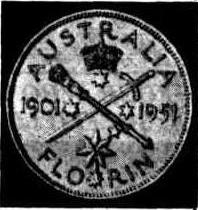 AUSTRALIAN
JUBILEE FLORIN. This special jubilee florin will be in circulation about the
end of this month. The Prime Minister- (Mr. Menzies) said last night that the
Melbourne Mint was now producing the coins from dies flown out from the London
Mint. The reverse (pictured) showed a mace and the sword of justice crossed
against a background of the Southern Cross, surmounted by the Imperial crown,
and including a seven-pointed star. The obverse showed the King's head as on
existing coinage. The reverse design was the work of a noted Victorian sculptor,
Mr. W. Leslie Bowles. AUSTRALIAN JUBILEE FLORIN. (1951, November 22).
The West Australian (Perth, WA : 1879 - 1954), p. 2. Retrieved from http://nla.gov.au/nla.news-article49001206
AUSTRALIAN
JUBILEE FLORIN. This special jubilee florin will be in circulation about the
end of this month. The Prime Minister- (Mr. Menzies) said last night that the
Melbourne Mint was now producing the coins from dies flown out from the London
Mint. The reverse (pictured) showed a mace and the sword of justice crossed
against a background of the Southern Cross, surmounted by the Imperial crown,
and including a seven-pointed star. The obverse showed the King's head as on
existing coinage. The reverse design was the work of a noted Victorian sculptor,
Mr. W. Leslie Bowles. AUSTRALIAN JUBILEE FLORIN. (1951, November 22).
The West Australian (Perth, WA : 1879 - 1954), p. 2. Retrieved from http://nla.gov.au/nla.news-article49001206
SPECIAL FLORIN The Melbourne Mint soon will begin producing a
special florin to commemorate the Royal visit. SPECIAL FLORIN.
(1953, December 24). Goulburn Evening Post (NSW : 1940 - 1957), p.
1 Edition: Daily and Evening. Retrieved from http://nla.gov.au/nla.news-article100389886
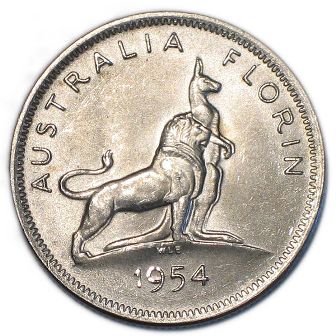 Right:
Reverse of the 1954 Australian florin commemorating the first visit of a
reigning monarch to Australia, designed by Leslie Bowles.
Right:
Reverse of the 1954 Australian florin commemorating the first visit of a
reigning monarch to Australia, designed by Leslie Bowles.
The New Florin
Sir,-The Queen's head on the new Australian
florin is the work of Mrs. Mary Gillick, and is that chosen by the Royal Mint
Advisory Committee, headed by the Duke of 'Edinburgh. The fault referred to by
Mr. 'R. G. Howard ("Herald," June 16) does not lie in the design for the
likeness to the Queen, but, I think, in the Australian reproduction of the
design. I have before me an illustrated article from the English "Country Life"
of November 28, 1952, showing (the new coinage. On the English florin the head
is finely and deeply engraved, and is in every way a satisfying
portrait.
(Miss) NORA KEMP. Hornsby.
The New Florin. (1953, June
18). The Sydney Morning Herald(NSW : 1842 - 1954), p. 2. Retrieved
from http://nla.gov.au/nla.news-article18376672
For their historic value, to teach young ones that sometimes
twenty cents is worth more then twenty cents, to feel how heavy silver may be in
the hand, it's well worth going back through your collections of old coins and
seeing if you wish to trade any for a holiday or keep them for all the memories
they hold in your hand.
As stated above Australian currency was decimalised on 14 February 1966 and the florin then equated to 20 cents in the new system. This was not the first time decimalising our currency was discussed:
FUGITIVE NOTES. By L.L.B. Decimal Coinage. The Federal Parliament has no doubt followed the wisest course in merely adopting. the report of the Decimal Coinage Committee, leavingit .for the Imperial authorities to make the initial practical move towards a unification of our systemn of coinage. It is curious that Great Britain has for so long clung to the effete and clumsy systems of coinage and weight and measures, the latter of which are the pet aversion alike of the school-boy and the commercial man. The nations of Europe, as well as Canada and America, have long since fallen into line by adopting the simple and readily understood decimal coinage without suffering any of those regrets or inconveniences which are alleged against it by the advocates of our British. system. The Federal Committee reports strongly in favour menided to the House of Commons by the British Decimal Coinage Commission 50 years ago. Briefly put, the Committe advises that the existing coins from sixpence upwards be retained, though possibly .the half crown may have to go, as it is not needed; that the existing florin be divided into 100 cents., that the threepenny piece be replaced by a new coin worth 10 cents, equal to two two-fifths of a penny of our present money, and that for the, present- bronze coins there should be substituted three new ones, to be known as the cent, 2 cents, and 4cents. Thus we should have 100cents equal to 1 florin, 10 florins equal to-I pound. The great advantage of the suggested decimal system is .that, though it alters the smaller coinage, it leaves the larger untouched; and seeing that our external commerce is conducted on the basis of the British sovereign, any alteration in that direction would involve consequences too serious to think of incurring voluntarily. The experience of other countries in converting their coinage leads us to believe that the benefits of the new system would be speedily in a country such as Australia, whose- the standard of education is certainly higher than it was in the nations which introduced the decimal system a quarter of a century ago. FUGITIVE NOTES. (1903, July 10). Fitzroy City Press (Vic. : 1881 - 1920), p. 3. Retrieved from http://nla.gov.au/nla.news-article65651319
DECIMAL COINAGE.
TO THE EDITOR OF THE ARGUS
Sir,-It is to
be hoped that some consideration will be given to the interesting letter from Mr
Barnard in jour today's issue
The report of the select committee appointed by
the federal Government in1907 recommended that the Commonwealth adopt a decimal
system of coinage and hat the sovereign, half sovereign florin shilling, and
sixpence be kept in use. The value, design, and denomination of these coins
might remain unchanged, but the new issues would show the new method of count.
How easy the change would be-the florin or 100 cents is one tenth of £1, the
shilling at 50 cents is half a florin, and the sixpence of 25 cents is one
fourth of a florin. What difficulty there is lies with the coins of lower
denomination The threepenny pieces would go the way of the crown piece. The four
penny piece, and the four shilling piece and would probably have to be replaced
by a new coin of the value of 10 cents one tenth of a florin The bronze coinage
might remain as it is, but the pennies and cents would go to the florin instead
of 24 and 50 halfpennies each 2 cents instead of l8 and lOO farthings, each 1
cent, msttid of 96 We need not trouble about the that thing which is seldom seen
in Australia of the halfpenny, but the value of the ubiquitous penny would be
….
Decimals are well taught in our schools and advantage could be at once
taken of the change. Practically all the world including Canada and America use
decimal coinage only dear old conservative England and some of her dependencies
adhere to the old system Progressive Australia is about to mint her own silver
coins. Why not take the opportunity of making the change to decimal
coinage?
ic, R. J. LARKIN,
Flinders-street, March 27
DECIMAL
COINAGE. (1908, March 28). The Argus (Melbourne, Vic. : 1848 -
1957), p. 19. Retrieved from http://nla.gov.au/nla.news-article10654452
This
discussion went on for decades until, finally the new Australian coins were
revealed. You will see the fifty cent piece was
originally round. Younger readers may not have ever seen a one cent or two cent
piece:
First look at decimal coins
FINAL
DESIGNS OF AUSTRALIA'S DECIMAL COINS AND, BELOW, IN ACTUAL SIZE
Australian
wildlife motifs will be featured in the reverse side designs of the new decimal
coins which will come into use in 1966, the Treasurer, Mr. Holt, said
yesterday.
The designs, which all depict Australian animal and bird-life, are
the work of a young Melbourne artist, Mr. Stuart Devlin. They will be carried on
the six decimal coins -one cent, two cent, five cent, 20 cent and 50
cent.
The' value of each coin will also be shown on the tail side in large
figures.
The obverse or head side of each coin will carry the year and the
Queens effigy,with the simple inscription "Elizabeth II Australia."
The
present coins carry the date on the reverse side and the inscription "Elizabeth
II Dei Gratia Regina F D." on the obverse side. Probably the most controversial
feature of the new coin design is the elimination of the inscription "F.D"
(defender of the faith).
In the first coinage of the present reign in 1954
the lettering F.D. was omitted. This led to considerable agitation from some
churches. The letters were replaced on the 1955 coins.
Mr. Holt said the
Australian wildlife theme proposed by Mr. Devlin had been accepted because of
the advantage of having each of the six coins as a "family" of designs.
The
wildlife theme also had the advantage of providing a link with the two
supporters of the Australian coat of arms – the kangaroo and the emu.
The
motifs to be shown on the six coins arc:
One cent - the feather tailed
glider;
Two cent - the frilled lizard;
Five cent - the echidna, or spiny
ant-eater;
Ten cent - the. lyrebird;
Twenty cent - the platypus;
Fifty
cent - coat of arms.! Mr. Holt said Mr. Devlin had done a remarkably
fine job
in adapting his designs to suit the circular metal shapes of the coins and in
making them an integral part of each coin.
Of the motifs on the existing
coins, the coat of arms at present appearing on the sixpence and the florin
would be replaced by a more accurate representation on the 50 cent piece.
The
kangaroo on the penny and halfpenny would be given a new dignity and a more
prominent appearance as a supporter of the coat of arms.
Mr. Holt said the
sheep motif at present appearing on the shilling, and the ears of wheat motif on
the threepence, would not be included. This was because the sheep was not a
native of Australia and the ears of wheat would not fit in with the wildlife
theme.
Both of these themes, however, would be prominently displayed in the
design for one of the new decimal notes.
Mr. Holt said priority would be
given to the production of the two bronze coins - the one cent and two cent
pieces - as these would be the only two which would not have exact equivalents
in the existing system.
Small-scale production of the one-cent coin had
already begun at the Melbourne Mint and this would be gradually stepped up over
the next few weeks.
The other coins would follow later, but it might not be
until towards the end of 1965 that a complete set of new decimal coins would
become available, Mr. Holt said. First look at decimal coins. (1964,
August 25). The Canberra Times (ACT : 1926 - 1995), p. 1. Retrieved
from http://nla.gov.au/nla.news-article105840018
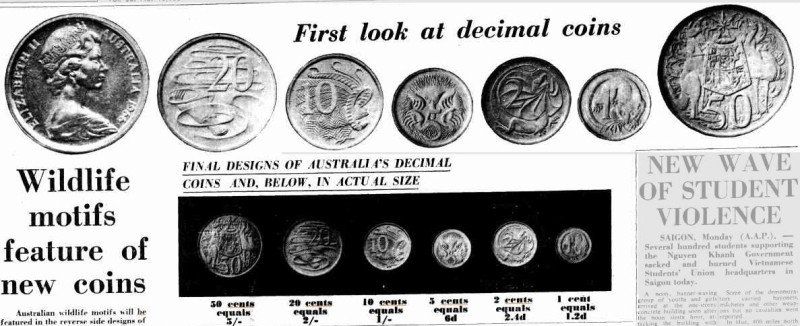

Contemporary coin collecting and appreciation began around the fourteenth century. During the Renaissance, it became a fad among some members of the privileged classes, especially kings and queens. The Italian scholar and poet Petrarch is credited with being the pursuit's first and most famous aficionado. Following his lead, many European kings, princes, and other nobility kept collections of ancient coins. Some notable collectors were Pope Boniface VIII, Emperor Maximilian[disambiguation needed] of the Holy Roman Empire, Louis XIV of France, Ferdinand I, Henry IV of France and Elector Joachim II of Brandenburg, who started the Berlin Coin Cabinet (German: Münzkabinett Berlin). Perhaps because only the very wealthy could afford the pursuit, in Renaissance times coin collecting became known as the "Hobby of Kings."
In coin collecting, the condition of a coin is paramount to its value; a high-quality example is often worth many times more than a poor example. Collectors have created systems to describe the overall condition of coins.
In the early days of coin collecting—before the development of a large international coin market—extremely precise grades were not needed. Coins were described using only three adjectives: "good," "fine" or "uncirculated". By the mid 20th century, with the growing market for rare coins, the American Numismatic Association helps identify most coins in North America. It uses a 1–70 numbering scale, where 70 represents a perfect specimen and I represents a barely identifiable coin. Descriptions and numeric grades for coins (from highest to lowest) is as follows:
• Mint State (MS) 60–70: Uncirculated (UNC)
• About/Almost Uncirculated (AU) 50, 53, 55, 58
• Extremely Fine (XF or EF) 40, 45
• Very Fine (VF) 20, 25, 30, 35
• Fine (F) 12, 15
• Very Good (VG) 8, 10
• Good (G) 4, 6
• About Good (AG) 3
• Fair (FA, FR) 2
• Poor (PR, PO) 1
Numismatics is the study or collection of currency, including coins, tokens, paper money, and related objects. While numismatists are often characterized as students or collectors of coins, the discipline also includes the broader study of money and other payment media used to resolve debts and the exchange of goods. Early money used by people is referred to as "Odd and Curious", but the use of other goods in barter exchange is excluded, even where used as a circulating currency (e.g., cigarettes in prison). The Kyrgyz people usedhorses as the principal currency unit and gave small change in lambskins;[1] the lambskins may be suitable for numismatic study, but the horse is not. Many objects have been used for centuries, such as cowry shells, precious metals, and gems.
Today, most transactions take place by a form of payment with either inherent, standardized, or credit value. Numismatic value may be used to refer to the value in excess of the monetary value conferred by law, which is known as the "collector value."
Economic and historical studies of money's use and development are an integral part of the numismatists' study of money's physical embodiment.
First attested in English 1829, the word numismatics comes from the adjective numismatic, meaning "of coins". It was borrowed in 1792 from French numismatiques, itself a derivation from Late Latin numismatis, genitive of numisma, a variant of nomisma meaning "coin". Nomisma is a latinisation of the Greek νόμισμα (nomisma) which means "current coin/custom", which derives from νομίζω (nomizō), "to hold or own as a custom or usage, to use customarily", in turn from νόμος (nomos), "usage, custom", ultimately from νέμω (nemō), "I dispense, divide, assign, keep, hold"
Coin collecting may have existed in ancient times. Caesar Augustus gave "coins of every device, including old pieces of the kings and foreign money" as Saturnalia gifts. Petrarch, who wrote in a letter that he was often approached by vinediggers with old coins asking him to buy or to identify the ruler, is credited as the first Renaissance collector. Petrarch presented a collection of Roman coins to Emperor Charles IV in 1355.
The first book on coins was De Asse et Partibus (1514) by Guillaume Budé. During the early Renaissance ancient coins were collected by European royalty and nobility. Collectors of coins were Pope Boniface VIII, Emperor Maximilian of the Holy Roman Empire, Louis XIV of France, Ferdinand I, Elector Joachim II of Brandenburg who started the Berlin coin cabinet and Henry IV of France to name a few. Numismatics is called the "Hobby of Kings", due to its most esteemed founders.
Professional societies organized in the 19th century. The Royal Numismatic Society was founded in 1836 and immediately began publishing the journal that became the Numismatic Chronicle. The American Numismatic Society was founded in 1858 and began publishing the American Journal of Numismatics in 1866.
In 1931 the British Academy launched the Sylloge Nummorum Graecorum publishing collections of Ancient Greek coinage. The first volume of Sylloge of Coins of the British Isles was published in 1958. In the 20th century as well the coins were seen more as archaeological objects. After World War II in Germany a project, Fundmünzen der Antike (Coin finds of the Classical Period) was launched, to register every coin found within Germany. This idea found successors in many countries.
References:
Numismatics. (2014, January 21). In Wikipedia, The Free Encyclopedia. Retrieved from http://en.wikipedia.org/w/index.php?title=Numismatics&oldid=591767642
Florin (Australian coin). (2013, December 11). In Wikipedia, The Free Encyclopedia. Retrieved from http://en.wikipedia.org/w/index.php?title=Florin_(Australian_coin)&oldid=585664940
Researched by A J Guesdon. Copyright Pittwater Online News, 2014. All Rights Reserved.